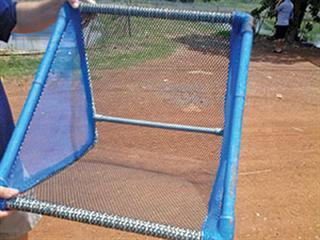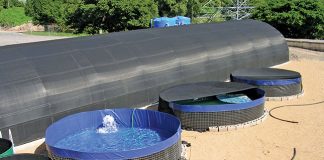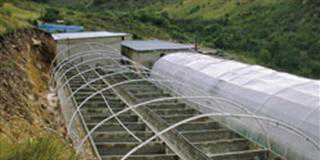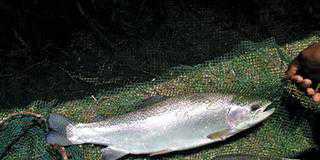
Fish farming, like any other type of agriculture, has its own unique gadgets. On a recent visit to Asia, I saw a wealth of innovations that make life easier on a fish farm. One extremely handy piece of equipment is the fish grader. This is used for sorting fish, so that evenly-sized stocking can take place, and the smaller fish are not subject to cannibalism or feeding domination by the bigger fish.
Traditionally, graders are aluminium boxes with smooth bars at the base that can be set at different spacings to allow smaller fish to fall between the bars, leaving the larger fish inside the box. Graders come in a range of sizes and prices vary from R3 000 to R5 000 each. In Thailand they also use netting graders made from plastic mesh stretched over a triangular PVC piping frame – simple but effective, for one size of fish only. The air-filled frame allows the grader to float, making it convenient to use.
At Nam Sai fish farm in Thailand, breeding ponds are scattered over a wide area and collecting the hatching eggs is an intensive daily activity. Every egg collector rides a bicycle with circular wire frames fitted over the handlebars. These frames carry several bowls at once, leaving the cyclist’s hands free to steer. The eggs are returned to a mobile incubator unit on wheels – a small trailer fitted with a platform holding incubator jars and a pump that recirculates water, keeping thousands of eggs oxygenated while still in the field.
A plastic-covered electronic balance is used to weigh each batch of eggs, and workers are paid by the number of eggs they collect each day, so no one sits around having tea. Ponds that contain hapas (simple portable cages made of poles and fine mesh) pose logistical problems for feeding when the hapas are far from the bank. One option is to wade to the hapa and feed the fish by hand, but the Thai have a smarter solution. They use a small 2l bucket fixed to the end of a long bamboo pole. Two feeders simply walk down the bank, one at one end of the pole filling it with feed, and the other emptying the buckets of pellets into each hapa from the comfort of dry land.

(Left) A mobile fish-incubator trailer on which a small pump powers several egg-incubators, keeping them alive and healthy prior to transport to the hatchery. (Right) The fish are concentrated for sorting in a hapa by pulling a pole underneath the hapa to lift the netting, forcing the fish into the end section.
Hand nets from asia
The most misused pieces of equipment I have seen on most SA farms are the poor-quality hand nets. Because they’re used daily, they should have robust frames and protective edge-covers to prevent chafing and ripping. Frames should be made of rigid piping or metal rod, not of flexible wire. And they should have straight edges to make it easy to catch fish.
Those used in abrasive concrete tanks should have a double lower-edge frame, or they chafe through the netting quickly. Few of these nets are available from SA retail outlets, although some specialised importers offer them at a price, imported from overseas.
Nicholas James is an ichthyologist and hatchery owner. Contact him at [email protected]. Please state ‘Aquaculture’ in the subject line of your email.













